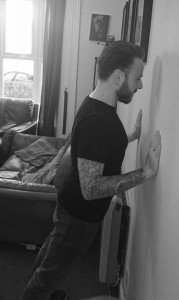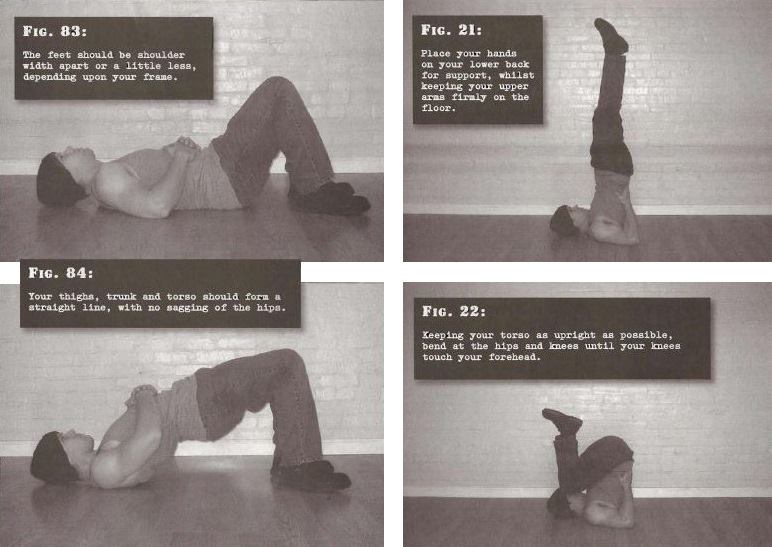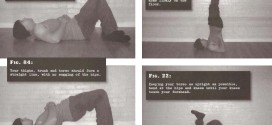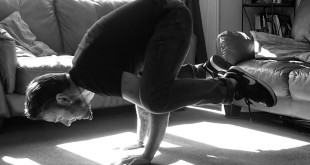After fourteen days of unleashing Convict Conditioning on my world, what had I learned? Hell of a lot it turns out, I’d picked a plan of attack, started from scratch, twice, and discovered those six simple looking disciplines* were deceptively complicated and interconnected. Furthermore not one kneecap was harmed in the production of this article.
First (Mis)Steps
 My initial approach was wrong straight out of the gate, I ignored the training plans at the back of the book and tried to do the exercises as intervals. I reasoned that I wasn’t unfit and had experienced some successes with High Intensity Interval Training in the past and tried to apply the same logic to CC, mostly because I’m a sucker for a tested routine I suspect. I chose to omit handstand press-ups as they looked, frankly, far too daunting to begin immediately. All the other progressions I took on at step one and tried to rattle through all five first steps in one giant interval. I lasted a week.
My initial approach was wrong straight out of the gate, I ignored the training plans at the back of the book and tried to do the exercises as intervals. I reasoned that I wasn’t unfit and had experienced some successes with High Intensity Interval Training in the past and tried to apply the same logic to CC, mostly because I’m a sucker for a tested routine I suspect. I chose to omit handstand press-ups as they looked, frankly, far too daunting to begin immediately. All the other progressions I took on at step one and tried to rattle through all five first steps in one giant interval. I lasted a week.
The first thing I discovered was how easy it was, the second was that it’s paradoxically quite tough at the same time, I’ll come back to this. The first few steps of each progression series are not designed to make Olympians wet the bed, they’re low impact manoeuvres to teach good form, build discipline and rehabilitate old niggles and injuries.
Interval Training works by rapidly rotating strenuous exercises that target different muscle groups. The relentless switches serve to sustain a high intensity workload and maximise impact and fat burning.
It became obvious that this wasn’t going to work with CC, the rushed energy of HIIT jarred with the gentleness of the introductory CC exercises and the mindful training atmosphere that Coach Wade teaches. I ended up half-hurrying through a lot of reps and feeling like I wasn’t working hard or clean enough to satisfy either ideal.
The exercises also began to impact each other. I was trying to follow short bridges – a typical pilates-style hip bridge – with shoulderstand squats, an inverted squat to rehabilitate knees. The target muscles were very different but the collateral impact on my core and lower back meant that I was working all the stabilising muscles over and over again which was kicking my ass! I wasn’t making any headway because I was accidentally overworking and by the time I came to the first ab-focused exercise I was too beat to put in a decent show.
Back To The Book
At the start of week two I went back to the training plans to do it the Coaches’ way. Luckily there is plenty of guidance to hand in the later chapters – Convict Conditioning details five prison themed plans that range in intensity from total beginner to hardened athlete.
-
New Blood
-
Good Behaviour
-
Veterano
-
Solitary Confinement
-
Supermax
I went for Good Behaviour which covers all six Progressions, two at a time in a day-on, day-off format. The plan puts a 2-day recovery buffer between short bridges and shoulderstand squats, clearly I’m not the first new fish to hit that particular roadblock!
My decision was informed by a reasonable foundation of fitness and a willingness to take on all of the big six. Had I been a complete beginner I’d have plumped for New Blood instead to find my feet. New Blood splits pushups, leg raises, pullups and squats, over two workouts a week. The more punishing bridges and handstand pressups are held back for when basics have been grasped and the training intensifies.
As I re-read the training section of the book I started to absorb The Coach’s training philosophy, essentially slow and steady always wins. He talks of ‘putting strength in the bank’ by training hard but not to excess. The point is training until total failure is no kind of long-term solution, it will likely produce impressive short-term gains but sooner or later the body will be so tired it will rebel, either failing, plateauing through constructive exhaustion or increasing the likeliness of illness.Respecting the body’s limits protects the joints and tendons so provides moderate gains that continue to mount up indefinitely. The key ingredients are patience and dedication. This approach surprised me, it’s incredibly holistic. For all its machismo the goal of the book is to be healthy as well as strong. I don’t know many plans that preach this kind of long-term concern for a practitioner’s quality of life. Convict Conditioning is quite clear that it is not a weight loss plan, it’s a strength and fitness training plan. Don’t get me wrong, six months in and I’ve traded a chunk of blubber for solid, lean muscle but it’s not specifically designed to hoover fat off. The coach touches on the ideas of living and eating clean but it’s not something he expands into theory.
Week 2
The next week went off without a hitch, I made time to train and committed myself fully but was careful to perform the exercises mindfully and with the best form I could. Some exercises came easier and I was able to hit progression standard (the target reps required before moving to the next step) in pressups and pullups off the bat. I kept the steady training philosophy in mind and decided to repeat them a few times before moving on. I surprised myself by holding a 2-minute headstand (with feet leaning lightly against the wall as permitted) for the first time ever too. I found the abdominal progression the hardest, leaving me with a deep burn and breathing hard, a curious development as this was traditionally my strongest suit. The bridge and squat progressions became less problematic once they had room to breathe and my reps there increased too. By the end of the first fortnight my lower back, a long term niggle, was feeling soothed and less achy for the gentle flexing of the bridges. So far so good.
The Exercises in Focus
The vast majority of people will be able do a few full pushups if so motivated, nobody is getting buff on wall pushups alone, nor is anyone meant to. The progression standard for wall pushups is 150, which is pretty high but fairly accessible for a movement 2-foot off horizontal. As I pushed through them I started to realise that Coach Wade wanted me to do something easy a lot of times to concentrate on getting it perfect. The lesson here was as much discipline as it was strength, a quality that I would try to apply to my future training.
I found the squat progression tough. The act of holding myself in a shoulder stand and controlling the weight shift of my descending knees was surprisingly demanding on my lower back and core, even distanced from the bridges. It was a great relief that the impact on my knees was pretty minimal and I didn’t feel any of the searing warnings that signalled three days of limping. This exercise was clearly very much about rehabilitation which suited me just fine. As the plan preceded squats with pullups (albeit embryonic ones) I built some back and shoulder stretches into my warm-up to help keep me loose whilst inverted.
At the end of the fortnight I felt that despite a stumble, I had broken into a sustainable pattern. I was still hungry for progression but mindful that I had to pay my dues before moving up the chain. Most importantly I had a plan and was prepared to see where Convict Conditioning took me…
PIC CREDIT – Convict Conditioning – Paul Wade http://www.dragondoor.com/b41/
 Paleo Minds Paleo diet, fitness and lifestyle.
Paleo Minds Paleo diet, fitness and lifestyle.






